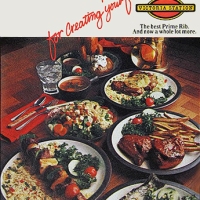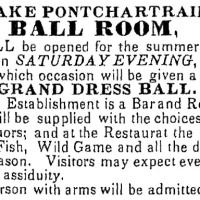 One remarkable accomplishment of Polynesian restaurants was how they lured the male diner without using steak as bait. Who would have believed mid-century Homo Americanus Modernus could swallow so many sugary rum drinks, pineapple chunks, and sticky sauces?
One remarkable accomplishment of Polynesian restaurants was how they lured the male diner without using steak as bait. Who would have believed mid-century Homo Americanus Modernus could swallow so many sugary rum drinks, pineapple chunks, and sticky sauces?
Another notable coup was that these tropical resorts were so obviously fake it was preposterous to accuse them of it. It is easy to imagine how Vic Bergeron, originator of Trader Vic’s, would have roared with laughter if charged with inauthenticity. (“Jeez, Honey, that was the whole point!”) Guests were well aware that the Tiki gods, fishnets, and outrigger canoes were artfully staged to stimulate escape fantasies, and vaguely conscious that the menu represented a culinary amalgam that never existed in the outside world. Bergeron once stated that the food of Polynesian islanders was “primitive” and “not acceptable to American tastes.” Stephen Crane, mastermind of Kon-Tiki Ports, admitted that many ingredients used in Polynesian dishes – bean sprouts, water chestnuts, tomatoes, and pea pods – didn’t grow on the islands. Who cared?
Don the Beachcomber and Trader Vic’s were the first Polynesian restaurants, beginning in California in 1934 and 1938 respectively. It was quite a while, though, before eating in pseudo-grass-huts became a fad. Around 1957 only about 20 Polynesian restaurants were known. But by 1962, after Hawaiian statehood and the debuts of the movie South Pacific and TV show Hawaiian Eye, the number had grown to 200, according to a National Restaurant Association estimate.
 Many were in big hotels where their job was to boost profits. As a Wall Street Journal headline succinctly put it in 1959, “Cocoanut Milk, Idols, Waterfalls Help Hotels Lift Food, Drink Take.” The Polynesian restaurant was about merchandising. Whether it was Bonko Bonko soup at Columbus’s Kahiki, Pineapple Teriyaki Garni at The Lahala House in Corpus Christi, or a take-home scorpion drink bowl (pictured) at Trader Vic’s, the concept was greater than all the inexpensive ingredients combined.
Many were in big hotels where their job was to boost profits. As a Wall Street Journal headline succinctly put it in 1959, “Cocoanut Milk, Idols, Waterfalls Help Hotels Lift Food, Drink Take.” The Polynesian restaurant was about merchandising. Whether it was Bonko Bonko soup at Columbus’s Kahiki, Pineapple Teriyaki Garni at The Lahala House in Corpus Christi, or a take-home scorpion drink bowl (pictured) at Trader Vic’s, the concept was greater than all the inexpensive ingredients combined.
The appeal of exotic drinks held steady longer than the rest of the package. Already by the mid-1960s, American and “continental” standbys were infiltrating menus. Steaks made a comeback and diners could also choose from a broad array of restaurant items not even remotely tropical such as clam chowder, chicken cordon bleu, and hush puppies. In the 1970s more adventurous diners rejected Cantonese, the core of Polynesian cuisine, for spicier Szechuan and Hunan. Decor was seen as a growing problem, too, as the cost of importing tapa cloths and outrigger canoes rose. Restaurateurs searching for a concept were counseled to think about Old English which was easier to accessorize, according to the journal Cooking for Profit, only requiring some paneling and “a few old swords, or other recognizable ‘art objects.’”
 By the mid-1970s and into the 1980s critics heaped scorn on things Polynesian, food especially. It seemed hard to believe NY Times critic Craig Claiborne had given it an ounce of credibility in 1958. Actor Yul Brynner sued Trader Vic’s in NY’s Plaza Hotel in 1979 after eating spareribs there and acquiring trichinosis. Ten years later Vic’s was booted out of the Plaza. Vic himself, having died in 1984, was spared the ignominious news. The long-lived Kahiki closed in 2000. Yet, even today Polynesian motifs cast a campy spell.
By the mid-1970s and into the 1980s critics heaped scorn on things Polynesian, food especially. It seemed hard to believe NY Times critic Craig Claiborne had given it an ounce of credibility in 1958. Actor Yul Brynner sued Trader Vic’s in NY’s Plaza Hotel in 1979 after eating spareribs there and acquiring trichinosis. Ten years later Vic’s was booted out of the Plaza. Vic himself, having died in 1984, was spared the ignominious news. The long-lived Kahiki closed in 2000. Yet, even today Polynesian motifs cast a campy spell.
© Jan Whitaker, 2008












 It's great to hear from readers and I take time to answer queries. I can't always find what you are looking for, but I do appreciate getting thank yous no matter what the outcome.
It's great to hear from readers and I take time to answer queries. I can't always find what you are looking for, but I do appreciate getting thank yous no matter what the outcome.



I worked at Sheraton Chicago hotel and often dined at Kontiki Ports. Food and service was excellent. Flying Cloud sailing ship decor terrific. I MISS THE PLACE